Human Orbital Spaceflights
![]()
International Flight No. 14Gemini 4USA |
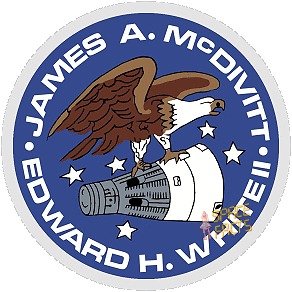 |
 |
![]()
Launch, orbit and landing data
walkout photo |
 |
|||||||||||||||||||
alternative crew photo |
alternative crew photo |
|||||||||||||||||||
alternative crew photo |
alternative crew photo |
|||||||||||||||||||
alternative crew photo |
||||||||||||||||||||
Crew
| No. | Surname | Given names | Position | Flight No. | Duration | Orbits | |
| 1 | McDivitt | James Alton | Command Pilot | 1 | 4d 01h 56m 12s | 62 | |
| 2 | White | Edward Higgins II | PLT | 1 | 4d 01h 56m 12s | 62 |
Crew seating arrangement
|
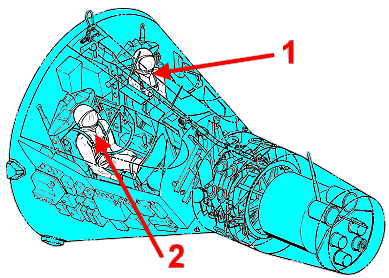 |
Backup Crew
|
 |
|||||||||||||||
alternative crew photo |
Hardware
| Launch vehicle: | Titan II GLV No. GT-4 (62-12559) |
| Spacecraft: | Gemini 4 (S/C-4 No. 1795) |
Flight
|
Launch from Cape Canaveraland landing 650 km
southwest of Bermuda Islands in the Atlantic Ocean. The Gemini spacecraft was a cone-shaped capsule consisting of two components, a reentry module and an adaptor module. The adaptor module made up the base of the spacecraft. It was a truncated cone 228.6 cm high, 304.8 cm in diameter at the base and 228.6 cm at the upper end where it attached to the base of the reentry module. The re-entry module consisted of a truncated cone which decreased in diameter from 228.6 cm at the base to 98.2 cm, topped by a short cylinder of the same diameter and then another truncated cone decreasing to a diameter of 74.6 cm at the flat top. The reentry module was 345.0 cm high, giving a total height of 573.6 cm for the Gemini spacecraft. The adaptor module was an externally skinned, stringer framed structure, with magnesium stringers and an aluminum alloy frame. The adaptor was composed of two parts, an equipment section at the base and a retrorocket section at the top. The equipment section held fuel and propulsion systems and was isolated from the retrorocket section by a fiber-glass sandwich honeycomb blast shield. The retrorocket section held the re-entry rockets for the capsule. The reentry module consisted mainly of the pressurized cabin which held the two Gemini astronauts. Separating the reentry module from the retrorocket section of the adaptor at its base was a curved silicone elastomer ablative heat shield. The module was composed predominantly of titanium and nickel-alloy with beryllium shingles. At the narrow top of the module was the cylindrical reentry control system section and above this the rendezvous and recovery section which holds the reentry parachutes. The cabin held two seats equipped with emergency ejection devices, instrument panels, life support equipment, and equipment stowage compartments in a total pressurized volume of about 2.25 cubic meters. Two large hatches with small windows could be opened outward, one positioned above each seat. Attitude control was effected by two translation-maneuver hand controllers, an attitude controller, redundant horizon sensor systems, and reentry control electronics, with guidance provided via an inertial measuring unit and radar system. The orbital attitude and maneuver system used a hypergolic propellant combination of monomethyl hydrazine and nitrogen tetroxide supplied to the engines by a helium system pressurized at 2800 psi. Two 95 lb translation thrusters and eight 23 lb attitude thrusters were mounted along the bottom rim of the adaptor, and two 79 lb and 4 95 lb thrusters were mounted at the front of the adaptor. Power was supplied by 3 silver-zinc batteries to a 22- to 30-volt DC two-wire system. During reentry and post-landing power was supplied by four 45 amp-hr silver-zinc batteries. Voice communications were performed at 296.9 MHz with an output power of 3 W. A backup transmitter-receiver at 15.016 MHz with an output power of 5 W was also available. Two antenna systems consisting of quarter-wave monopoles were used. Telemetry was transmitted via three systems, one for real time telemetry, one for recorder playback, and a spare. Each system was frequency-modulated with a minimum power of 2 W. Spacecraft tracking consisted of two C-band radar transponders and an acquisition-aid beacon. One transponder is mounted in the adaptor with a peak power output of 600 W to a slot antenna on the bottom of the adaptor. The other is in the reentry section, delivering 1000 W to three helical antennas mounted at 120-degree intervals just forward of the hatches. The acquisition-aid beacon was mounted on the adaptor and had a power of 250 mW. At the time of reentry, the spacecraft would be maneuvered to the appropriate orientation and equipment adaptor section would be detached and jettisoned, exposing the retrorocket module. The retrorockets consisted of four spherical-case polysulfide ammonium perchlorate solid-propellant motors mounted near the center of the reentry adaptor module, each with 11,070 N thrust. They would fire to initiate the spacecraft reentry into the atmosphere, with attitude being maintained by a reentry control system of 16 engines, each with 5.2 N thrust. The retrorocket module would then be jettisoned, exposing the heat shield at the base of the reentry module. Along with the ablative heat shield, thermal protection during reentry was provided by thin Rene 41 radiative shingles at the base of the module and beryllium shingles at the top. Beneath the shingles was a layer of MIN-K insulation and thermoflex blankets. At an altitude of roughly 15,000 meters the astronauts would deploy a 2.4-meter drogue chute from the rendezvous and recovery section. At 3230 meters altitude the crew releases the drogue which extracts the 5.5-meter pilot parachute. The rendezvous and recovery section are released 2.5 seconds later, deploying the 25.6-meter main ring-sail parachute which is stored in the bottom of the section. The spacecraft is then rotated from a nose-up to a 35-degree angle for water landing. At this point a recovery beacon is activated, transmitting via an HF whip antenna mounted near the front of the reentry module. Gemini 4 was launched from Complex 19 at 15:15:59.562 UTC and inserted into a 162.3 x 282.1 km Earth orbit at 10:22:05 UTC. This was the first launch, which was broadcasted on television to twelve European nations using the satellite "Early Bird" and for the first time the new Mission Control Center in Houston, Texas, was used. Mail goals of Gemini 4 were the first multi-day-spaceflight of the United States, and the first American extra-vehicular activity (EVA). On the first orbit, James McDivitt attempted to rendezvous with the spent Titan second stage. This was unsuccessful for a number of reasons. Especially here was no radar on board Gemini 4 to give a precise range to the target, so the astronauts had to rely on their visual depth perception to estimate the range, and this differed for the two men. Initially James McDivitt estimated the distance at 400-500 feet (120 - 150 m), while Edward White believed it was closer ("a little over 200 feet (61 m)"). The first EVA of an U.S. astronaut occurred on June 03, 1965 (Edward White in 36 minutes). After wrestling with a jammed latch and pushing back the stiff spacecraft hatch, Edward White stood in his seat and installed a 16-mm camera outside Gemini 4 to record the EVA, becoming slightly out of breath. He used a hand-held maneuvering gun. With bursts from this zip gun he was able to "walk" around the capsule, but after short time the compressed oxygen fuel bottle was empty. He was also able to mount and dismount the camera and move and remove electrical connections from outside the capsule. Edward White inspected Gemini 4, then evaluated his umbilical, which turned out to be useful for limiting distance, but not for more precise maneuvering. In addition to supplying oxygen, the 7-m (25-ft) umbilical carried communication and bioinstrumentation lines and a load-alleviating tether. The umbilical was covered by a thin layer of gold to protect it from the Sun's heat. He accidentally smeared James McDivitt's window before returning to his seat and recovering the camera. He intentionally discarded his thermal over gloves and helmet sun visor before returning to Gemini 4. But Edward White had big problems to come back into the capsule, because there were problems to lock the hatch. James McDivitt had to help him. After the door was latched Edward White sat back, physically exhausted, sweat streaming into his eyes and fogging his faceplate. James McDivitt also felt tired, so they rested before extending a radio antenna to find a ground-based voice and tell Earth all was well. The hatch was not reopened as planned to discard EVA equipment. But the first EVA of an American astronaut was successful. All secondary objectives were met except one. The secondary objective of station keeping and rendezvous was only partially successful because separation and rendezvous was not attempted due to fuel consumption. All in all, 11 scientific experiments were performed, including observations, photography work. The engineering experiment Electrostatic charge gave higher readings than expected. Onboard were also a Proton-Electron Spectrometer and a Tri-Axis Magnetometer. One medical experiment was the Phonocardiogram experiment, which had sensors attached to their bodies that measured heartbeat rates, especially during liftoff, EVA, and reentry. Gemini 4 missed its mark by 80 km, but within a few minutes the capsule was recovered by the USS Wasp. A malfunctioning thruster caused the roll to be much faster than planned, and the landing was rough. |
EVA data
| Name | Start | End | Duration | Mission | Airlock | Suit | |
| EVA | White, Edward | 03.06.1965, 19:34 UTC | 03.06.1965, 20:10 UTC | 0h 36m | Gemini 4 | G4C No. 8 | |
| IVA | McDivitt, James | 03.06.1965, 19:34 UTC | 03.06.1965, 20:10 UTC | 0h 36m | Gemini 4 | G4C No. 3 | |
Photos / Graphics
 |
 |
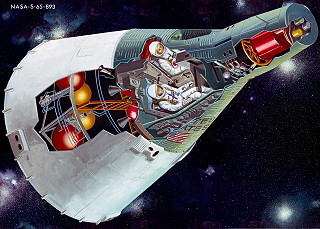 |
 |
 |
 |
 |
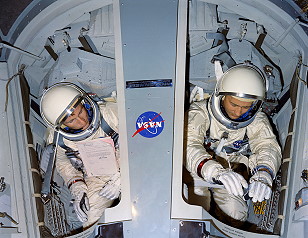 |
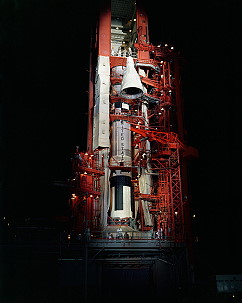 |
 |
 |
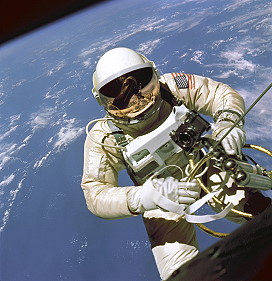 |
 |
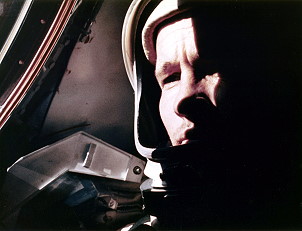 |
 |
 |
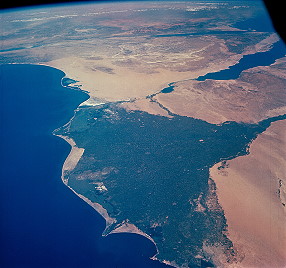 |
 |
 |
|
more EVA photos |
|
| © |  |
Last update on June 04, 2020.  |
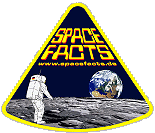 |